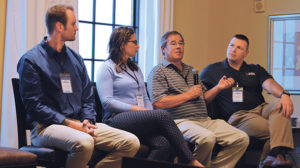Discussing the future of the propane industry

Retail propane company decision-makers on the panel are, from left, Ricky Hobday, Nicole Sullivan, John Weigel and Frank Edwards. Photo by LP Gas
On the final day of the LP Gas Growth Summit, four propane retailers from different corners of the country came together to discuss the challenges facing the industry.
The panelists included Arizona-based A&B Propane owner Ricky Hobday; Nicole Sullivan, senior vice president of Virginia-based Anderson Propane Service; Frank Edwards, general manager of Ohio-based Linden’s Propane; and John Weigel, operations manager of California-based Ted Johnson Propane.
LP Gas magazine Editor-in-Chief Brian Richesson led the discussion on developing the industry’s offerings for future growth, retailer technology and workforce development.
Thoughts on Randy Thompson’s Gallon Challenge
The panel discussion came on the heels of Randy Thompson’s presentation. The founder and senior adviser of ThompsonGas outlined his 4-billion-gallon growth challenge for the propane industry. LP Gas asked for thoughts on the challenge and the idea of pursuing growth in the industry.
“We cannot just think that residential gas is going to be there all the time,” Edwards says. “Houses are built better with thicker walls, better insulation and appliances that use less gas than ever. We have to think of ways to offset that and grow. If you are not growing, you are dying.”
Hobday followed in favor of the challenge, saying aggressive goals like these are important for his work in Arizona’s unique propane market.
“It seems that aggressive goals in nontraditional directions – like autogas, generators and such – can grow us across the board and grow market share,” Hobday says.
Growing propane’s market share in a competitive energy environment is an important issue for Sullivan. She admits to some decline in total gallons sold throughout the industry, so refraining from evolving is not an option.
“We all have to figure out these new markets or how to take some of the market share from these other energy sources,” Sullivan says. “Which is something we are working on. We all need to do something.”
Rounding out the question was Weigel, who touched on the opportunities propane-powered water heaters can bring to the industry. Water heaters, which are a key avenue to growth in Thompson’s gallon challenge, were a successful venture for Weigel during his work in the early 1990s.
While working for Suburban Propane, Weigel sold over 300 water heaters to customers in a small town in Oregon through a leasing program. Weigel would lease water heaters to customers for $19.92. The customers would sign a contract, agreeing they would purchase propane from the retailer for five years.
“These are year-round gallons,” Weigel says. “[Propane-powered water heaters] are one area when we talk about heating and people love it.”
What are some ways the industry can grow in the next five years
In his presentation, Thompson pointed out potential growth the autogas market can bring to the propane industry. According to Thompson, propane currently powers 6 to 7 percent of the school buses in the United States. If the propane industry can get that number up to 30 percent, there would be half a billion to three-quarters of a billion gallons of growth.
To follow up on this point, LP Gas asked panelists what avenues to growth they see, and many agreed autogas will play a major role.
“I am a strong believer in the autogas industry,” Weigel says. “I think these are the next big gallons ahead of us.”
Weigel touched on the transportation laws going into place in California and their effects on the propane industry moving forward. Transportation laws concerning low carbon emitting fuels will quickly spread across the country, he warns.
“You have to be involved in your association at your state and be involved in government affairs,” Weigel says. “If we don’t start fighting against some of this stuff, trust me, everything in California is going to be electrified.”
Edwards echoed that autogas is a valuable growth option, but admits some retailers are slow to move into this sector.
“I like the autogas portion because it gives you year-round gallons – consistent gallons,” Edwards says. “I think many of us are unsure on how to do it. How to get started, what is step ‘A’ and what is step ‘B.’”
Edwards talks about how the upfront costs of developing an autogas business segment can seem like an uphill battle to some retailers, but the profit potential is there.
What role does technology play in your company’s growth
Technology is continually evolving into an essential tool for retailers looking to improve efficiencies. LP Gas asked panelists the role technology plays in their company’s growth and how technology can improve overall industry growth.
“Sometimes I see marketers spend all of this money on technology and they forget to water it,” Sullivan says. “It is just a tool and it is not going to work or grow your business, or make you more efficient just because you bought it. You have to continue to utilize it and figure out what are ways to use it in something you didn’t know you could.”
Sullivan’s company uses tank monitors and back-office software. She says retailers need to invest in technology to see the positive effect on their business.
As someone who doesn’t use much technology but looks to add more, Hobday comes from the other side of the retailer spectrum.
“Part of growth in the industry is using technology to save time,” Hobday says. “You may not be able to control the cost of gas or something, but efficiencies, driver time and office time are huge. They can add up in a small amount of time.”
Hobday does use technology to help educate customers who may not know much about the propane industry.
“Our operation uses a tablet that carries information from the [Propane Education & Research Council], and we created slideshows to inform and educate our customers so they know it is safe and better to use propane on any of their appliances,” Hobday says. “I think the future is through technology. Whether that be through social media or software, education and research is important in our area and we use technology to do that.”
Developing the future workforce
LP Gas asked panel members how their operations are addressing the future of their workforce.
Sullivan recalls how a driver reached out to her, asking for a job and saying he only wanted to work in the winter, which Sullivan jokes was like hitting the lottery. Weigel and Edwards touched on similar points, saying they get candidates to fill openings. However, they noted that sometimes these candidates aren’t best suited for the job or company.
“What I see in this industry is people have a tendency to hire warm bodies,” Weigel says. “When you are hiring, you want to make sure you hire slow and fire fast.”
Edwards, who says he has 12 drivers with a tenure of 29 years, will soon face the issue of losing one to two of those drivers a year. Finding the correct person to fill these roles is a challenge.
“I really try to adopt the philosophy to hire a good person,” Edwards says. “If they are a good person who wants to work, I can teach them to drive, I can teach them to deliver propane, I can teach them what we need them to do. But will they hold their integrity at 2 a.m. and hold that leak check when they are freezing? Will they make a mistake and not be up front about it so we can correct it? I have always had the philosophy of hiring good people and not hiring positions.”
















